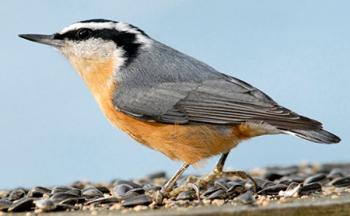The Squeaky Bird of the Forest

Red-breasted Nuthatch.
Photo credit: Jim Williams
by Val Cunningham
Contributing Writer
These long-billed, active little birds zigzag all over a tree in search of a meal, sounding like tiny tin horns as they stay in contact with their kind.
A group of bird watchers walked the trails at Tamarack Nature Center recently, on the lookout for late migrants as well as birds that will be around all winter. We’d come to this large park in White Bear Township because it often produces some pleasant surprises.
Motion and commotion up ahead soon caught our eyes, compelling us to stop and watch a fascinating display of avian foraging in a stand of spruce trees.
Small birds flitted in and out of the branches, and a constant “buh-Dee, buh-Dee” call quickly identified many as black-capped chickadees. But a few even smaller birds were mixed in with the ‘dees, birds with lovely blue-gray backs and dramatically striped faces.
These small birds were communicating with each other, too, and it was their calls, almost more than their plumage pattern, that pinpointed their identification. Yes, these were red-breasted nuthatches, the short-tailed smaller cousins of the familiar white-breasted bird, a fine reward in the middle of a long bird-watching tromp. They sound a bit like the larger nuthatches, although their call is higher pitched and more nasal. Hear the red-breasted variety here. Now compare their call to the white-breasted nuthatch’s, here.
Seed whackers
We stood and watched for many minutes, transfixed by the sight of the chickadees exploring needles and branches for small insects and nuthatches landing on spruce cones, jabbing their long beaks inside to extract a plump seed. With a spruce seed clamped in their bill, they’d flit to a nearby oak tree to either eat the meat or tap the seed into the bark for later consumption.
Both kinds of nuthatches are named for the way they approach seed consumption. Unlike chickadees, who hold a food item with both feet and hammer it with their beaks, nuthatches wedge a seed into bark and hack it into manageable pieces. The “hatch” in their names suggests that hacking activity.
The red-breasted kind are more lively than their cousins, moving rapidly up, down and across a branch or tree trunk, zigzagging and issuing frequent squeaky calls to keep in touch with their companions. (White-breasteds are known for their slower, head-down spiral down tree trunks, and for a lower-pitched “yank, yank” call). The red-breasteds are also bolder, seeming almost tame around feeding stations, allowing humans to approach closely before flying off. Some people even train them to eat out of their hands.
Both kinds are often found in a mixed flock of birds foraging together, with vocal little chickadees leading nuthatches, kinglets and downy woodpeckers through the woods.
Winter visitor
Red-breasted nuthatches breed in Canadian forests, then some migrate to spend the winter in our state, especially if food sources are scarce in the north. When conditions are bad, such as when the cone crop fails and/or the weather is particularly vile, great numbers of red-breasted nuthatches flood southward, a movement called an irruption. Last winter saw a major irruption of nuthatches all over the United States and some of those birds may still be in our area.
Since irruptions tend to occur every 2 to 4 years, we may not see great numbers of these handsome little birds this fall and winter. Still, it’s worth looking for them when you’re outdoors. Check stands of conifers in parks and woodlands (and even evergreens around parking lots), and keep an eye on your suet and seed feeders this winter. One or more of these “talkative, irrepressible woodland gnomes” (as Winsor Marrett Tyler describes them in Life History of North American Birds) might drop in to ‘hatch a snack.
St. Paul, Minn., resident Val Cunningham, who leads bird hikes for the St. Paul Audubon Society and writes about nature for local, regional and national newspapers and magazines.



